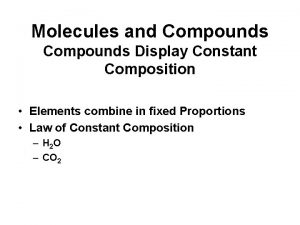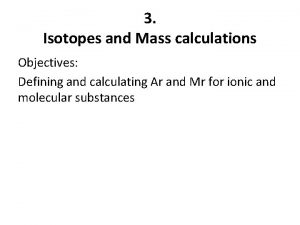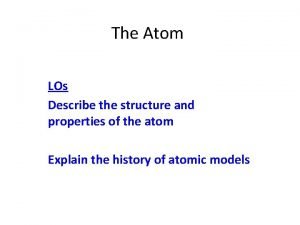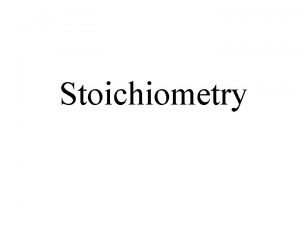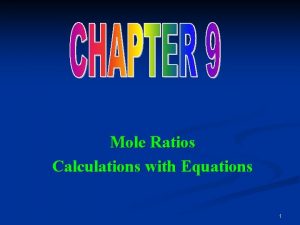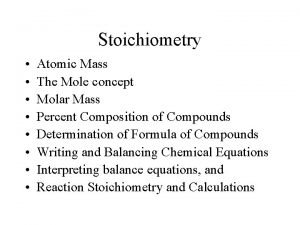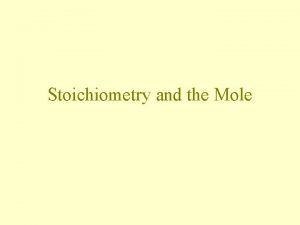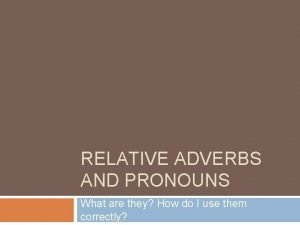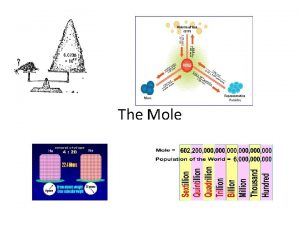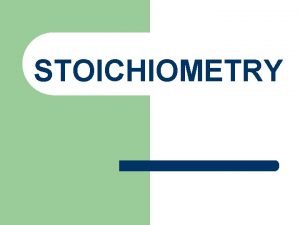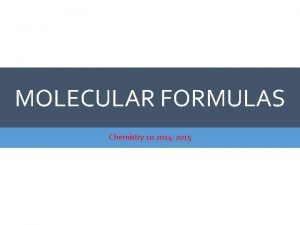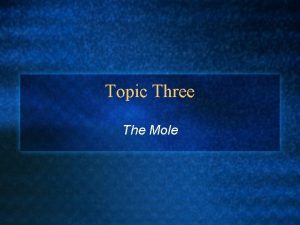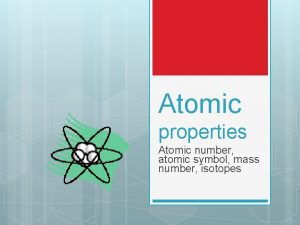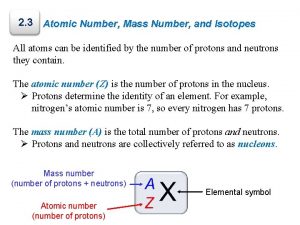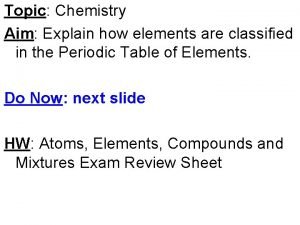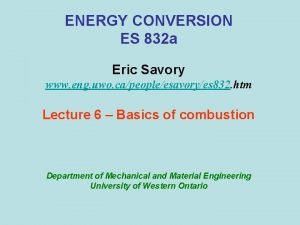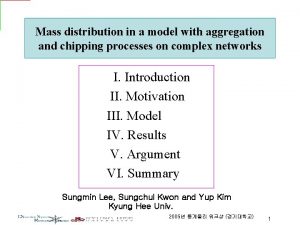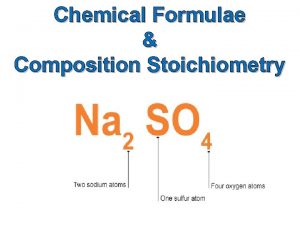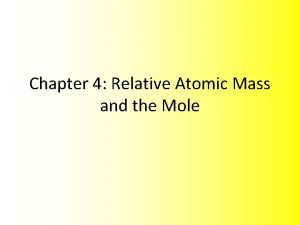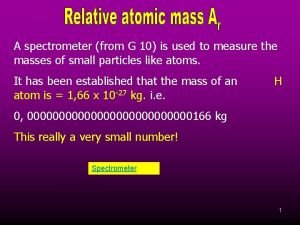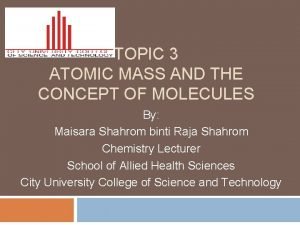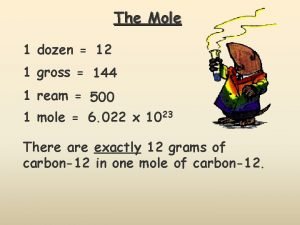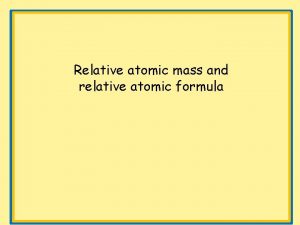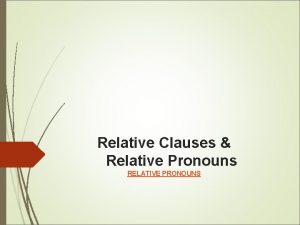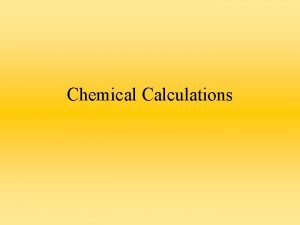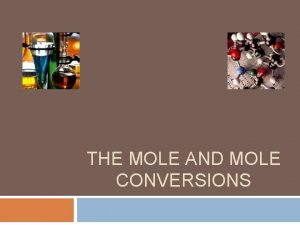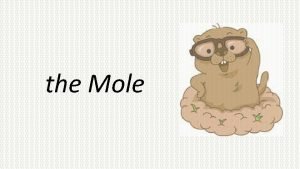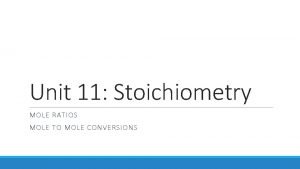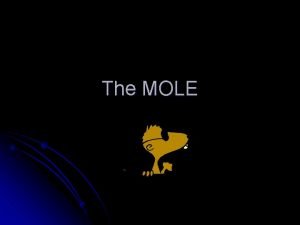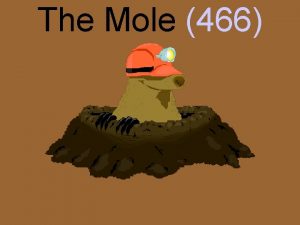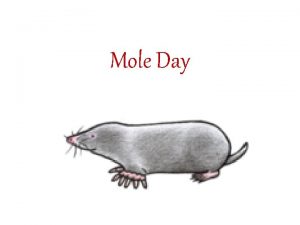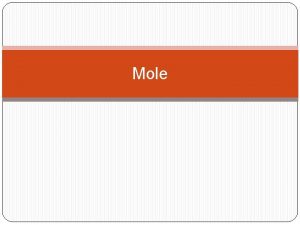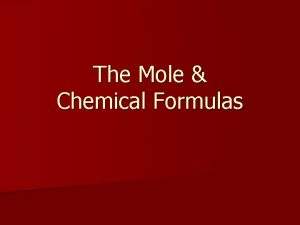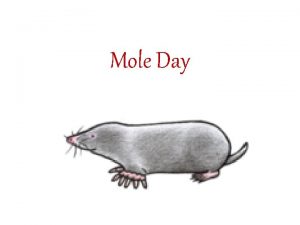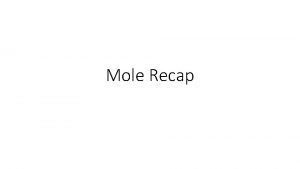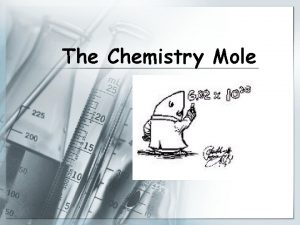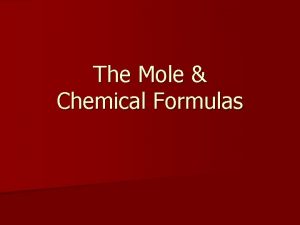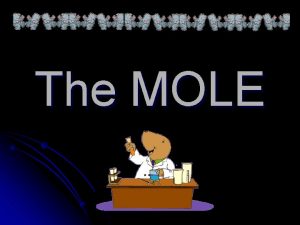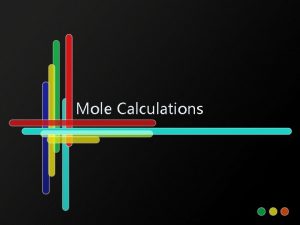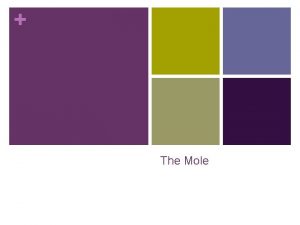Atomic Mass and the Mole Relative Atomic Mass










































- Slides: 42

Atomic Mass and the Mole

Relative Atomic Mass • Units of grams are TOO LARGE for atoms! • Relative atomic mass – compare to small particles – amu – “atomic mass units”

Average atomic mass • Average atomic mass: weighted average mass of all isotopes of an element • Weighted by % abundance of isotopes Example: Average atomic mass = 63. 55 amu 69. 17% Copper-63 (NOT 64 amu – because it’s weighted) 30. 83% Copper-65 • Find average atomic mass on the periodic table • Molecular mass of individual compounds, or formula mass of individual formula units found by adding individual atomic masses.

Units of amu are used for measuring single atoms, molecules, or formula units


The Mole • 1 mole = 6. 02 × 1023 particles Avogadro’s number • It is the number of atoms in exactly 12. 0 g of carbon-12

What is a mole? • A counting number (like a dozen) – If you have a dozen cookies, how many do you have? – If you have a mole of cookies, how many do you have? – If you have 3. 5 dozen cookies, how many do you have? – If you have 3. 5 moles of cookies, how many do you have?

How big is a mole? • It is HUGE. If every person on earth counted A mole of basketballs out atoms during his or her entire life, would countingfill anfour atombags every the second, it would 3 million years to sizetake of the earth. count out a mole of atoms.

Molar Mass • • Mass of one mole of a substance Units are g/mol Find molar mass on periodic table Molar mass of compounds found by adding individual molar masses

Units of g/mol (grams per mole) are used for measuring a mole of particles

Practice • What is the molar mass of each of the following elements? – Sodium (Na) – Nickel (Ni) – Xenon (Xe)

Practice • What is the molar mass of each of the following compounds? – H 2 O – NH 3 – C 2 H 6 O

REMEMBER: Atomic mass and molar mass are the same number, just different units.

ATOMS: THE BUILDING BLOCKS OF MATTER

Late 1700 s – Study of reactions led to new ideas Law of conservation of mass: Mass can’t be created or destroyed by ordinary chemical or physical reactions Law of definite proportions: A compound contains the same proportions of mass regardless of sample size Ex. Na. Cl will always be 39. 9% Na and 60. 1% Cl Law of multiple proportions: If two or more compounds of the same two elements exist, then the ratio of the masses are ratios of whole numbers Ex. C and O can combine to form both CO and CO 2

John Dalton Billiard ball model (1803) John Dalton viewed the atom as a small solid sphere.

John Dalton’s Atomic Theory: (Early 1800 s) 1. 2. 3. 4. 5. All matter is made of atoms The same elements have exactly the same atoms. In other words, all atoms of an element are identical Atoms cannot be divided, created, or destroyed Atoms of different elements combine in whole-number ratios to form compounds Atoms are combined, separated, or rearranged in chemical reactions

Modern Atomic Theory (slight changes to Dalton’s theory) 2. Atoms of the same element CAN be different (isotopes and ions) 3. Atoms CAN be divided – protons, neutrons, and electrons – nuclear reactions can split an atom

Models of the Atom: The smallest particle of an element that retains the chemical properties of that element (reactivity, etc. )

We now understand that the atom is composed of: Nucleus Protons Neutrons electrons

Discovery of the Electron

J. J. Thompson

J. J. Thomson Experiment: Cathode ray tube (1897) Discovered electron!!! Measured charge-to-mass ratio of electron Electron is negatively charged

Thomson’s Plum Pudding Model


Robert Millikan

Robert Millikan Experiment: Oil drop experiment (1909) Measured charge of electron Both charge of electron and chargeto-mass ratio were used to determine the mass of an electron Mass of electron is 1/1837 mass of hydrogen atom

Discovery of the nucleus

Ernest Rutherford

Ernest Rutherford Experiment: Gold foil experiment Discovered nucleus!!!! All mass of an atom is in the nucleus Nucleus is VERY massive


Rutherford’s model of the atom


Subatomic Particles Symbol Charge Mass Electron e- -1 0 Proton p+ +1 1 Neutron n 0 0 1

Atomic Basics Atomic number: Number of protons Identifies an element Mass number = protons + neutrons ALWAYS a whole number NOT on periodic table

A proton and neutron have about the same mass. An electron is about 1/2000 the mass of a proton A neutral atom has the same number of electrons as it has protons Nuclei are held together by nuclear forces The electrons determine the size of the atom Electrons move so fast in such a tiny area they make the atom seem solid (like a moving fan blade)

Isotopes Atoms of the same element with different masses. In other words, atoms with the same number of protons but different number of neutrons

Nuclear symbol: Mass number Element symbol Atomic number Hyphen notation: helium-4 Element name Mass number

Quiz 3 A What is the atomic mass of fluorine (F)? 2. What is the molar mass of Tin (Sn)? 3. What is the molar mass of magnesium chloride (Mg. Cl 2)? 4. What is the molecular mass (mass of one molecule) of propane (C 3 H 8)? 1. Show all work for all calculations!

Quiz 3 B

Quiz 3 C

Quiz 3 D How many grams are in 3. 50 mol Au? How many molecules are in 1. 21 g CO 2?
 Is atomic mass and relative atomic mass the same
Is atomic mass and relative atomic mass the same Is atomic mass and relative atomic mass the same
Is atomic mass and relative atomic mass the same Stoichiometry worksheet #2 (mole-mass mass-mole problems)
Stoichiometry worksheet #2 (mole-mass mass-mole problems) Mole-mass-volume relationships
Mole-mass-volume relationships Distinguish between mass number and atomic mass.
Distinguish between mass number and atomic mass. Relative atomic mass of barium
Relative atomic mass of barium Relative atomic mass of boron
Relative atomic mass of boron Relative atomic mass
Relative atomic mass Relative atomic mass
Relative atomic mass Stoichiometry: mole-mole problems
Stoichiometry: mole-mole problems Mole mole factor
Mole mole factor Phosphorus + oxygen
Phosphorus + oxygen Stoichiometry mole-mole
Stoichiometry mole-mole How to convert to molar mass
How to convert to molar mass Magnesium atomic number
Magnesium atomic number Atomic mass vs molar mass
Atomic mass vs molar mass What is a mole
What is a mole Stage 15 relative clauses and relative pronouns
Stage 15 relative clauses and relative pronouns Relative clauses jeopardy
Relative clauses jeopardy Relative adverbs list
Relative adverbs list Lesson 7 lethal dose toxicity answer key
Lesson 7 lethal dose toxicity answer key Convert from mass to moles
Convert from mass to moles How to get moles from volume
How to get moles from volume Empirical formula poem
Empirical formula poem Formula mass vs gram formula mass
Formula mass vs gram formula mass Joint frequency vs marginal frequency
Joint frequency vs marginal frequency Trends in the periodic table of elements
Trends in the periodic table of elements Atomic raduis
Atomic raduis Atomic number vs atomic radius
Atomic number vs atomic radius Sulfur atomic number and mass
Sulfur atomic number and mass Atomic mass cl
Atomic mass cl Nuclear stability
Nuclear stability Mass number of boron
Mass number of boron Molar mass of oxygen
Molar mass of oxygen Relative formula mass
Relative formula mass Relative formula mass of caco3
Relative formula mass of caco3 Formula mass vs molecular mass
Formula mass vs molecular mass Why fibonacci series is used in agile
Why fibonacci series is used in agile Co2 relative molecular mass
Co2 relative molecular mass Relative molecular mass
Relative molecular mass Why is 144 called a gross
Why is 144 called a gross Hình ảnh bộ gõ cơ thể búng tay
Hình ảnh bộ gõ cơ thể búng tay Ng-html
Ng-html





